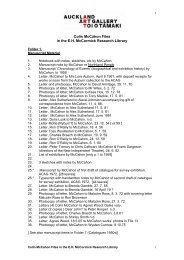You also want an ePaper? Increase the reach of your titles
YUMPU automatically turns print PDFs into web optimized ePapers that Google loves.
Ceramics / Glass / StoneGenerally a ceramic will have a clay body,often with a glaze applied to the surface todecorate or waterproof it. The glaze is alayer of glass fused to the clay fabric. Likeglazes, glass is composed of silica, fluxesand colourants. It is an amorphous structurewhich means that although it is a solid,it is not crystalline and the atoms arearranged as in a liquid.Causes of DeteriorationCeramics, glass and stone are susceptible to damagefrom changes in the environment. Fluctuations inhumidity levels can cause salts in ceramic and stoneobjects to alternately dissolve and recrystallise, thus settingup stresses which may result in cracking or flaking.The crizzled surface on some old glass objects is theresult of the glass reacting with the moist atmosphere.Some old glass objects can be easily damaged by evenslight changes in the environment.Because ceramics, glass and stone expand withheating and contract when cool, temperature fluctuationsaccelerate their deterioration by building up stressthrough constantly changing dimensions. This can alsocause cracking or flaking. These materials, therefore,should not be exposed to hot lights, sunlight or heaters.Ceramics are probably one of the most stable formsof decorative artefacts and there is really no reason thatthey should deteriorate except in unusual situations.However the most common form of damageto ceramics and glass is the result ofmechanical shock upon impact, caused bydirect or indirect human intervention.Breakage, scratching or abrasion can occuras a result of handling, storage, packing anddisplay.Atmospheric pollution, such as highconcentrations of sulphur dioxide, cancause damage to these materials through acidic actionon the surface. Particulate pollution can disfigureceramics and marble either temporarily or permanently,depending on the degree of penetration.HandlingEliminate all unnecessary handling. This extends to routinewashing and dusting. Try to arrange storage so thatdust and dirt does not settle on objects. Remember, ifyou don’t have to handle the object the most commoncause of damage is eliminated.Inspection of an object to verify its marking, hallmarkor signature, generally located on its base, canoften be eliminated with a photocopy machine. A reproductioncan be kept with the object’s folder.Prior to handling, try to determine the nature andextent of mends, rebuilds, replacements and fills. Neverpick up an object by a protrusion such as a spout, handleor attachment. Repairs most often occur in theseareas.47
















